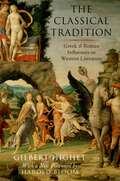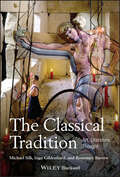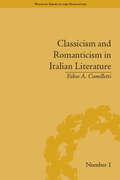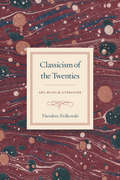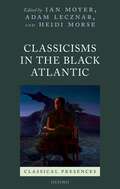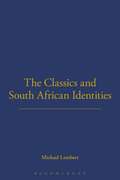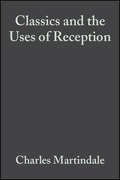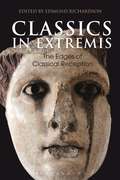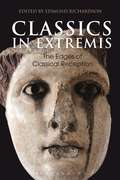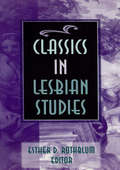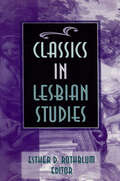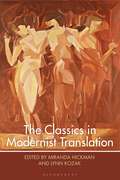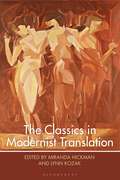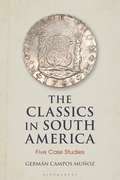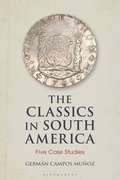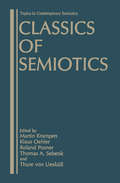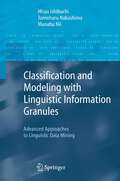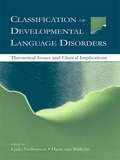- Table View
- List View
The Classical Tradition: Greek and Roman Influences on Western Literature
by Gilbert HighetOriginally published in 1949, Gilbert Highet's seminal The Classical Tradition is a herculean feat of comparative literature and a landmark publication in the history of classical reception. As Highet states in the opening lines of his Preface, this book outlines "the chief ways in which Greek and Latin influence has moulded the literatures of western Europe and America". With that simple statement, Highet takes his reader on a sweeping exploration of the history of western literature. To summarize what he covers is a near-impossible task. Discussions of Ovid and French literature of the Middle Ages and Chaucer's engagement with Virgil and Cicero lead, swiftly, into arguments of Christian versus "pagan" works in the Renaissance, Baroque imitations of Seneca, and the (re)birth of satire. Building momentum through Byron, Tennyson, and the rise of "art of art's sake", Highet, at last, arrives at his conclusion: the birth and establishment of modernism. Though his humanist style may appear out-of-date in today's postmodernist world, there is a value to ensuring this influential work reaches a new generation, and Highet's light touch and persuasive, engaging voice guarantee the book's usefulness for a contemporary audience. Indeed, the book is free of the jargon-filled style of literary criticism that plagues much of current scholarship. Accompanied by a new foreword by renown critic Harold Bloom, this reissue will enable new readers to appreciate the enormous legacy of classical literature in the canonical works of medieval, Renaissance, and modern Europe and America.
The Classical Tradition: Art, Literature, Thought
by Michael Silk Ingo Gildenhard Rosemary BarrowThe Classical Tradition: Art, Literature, Thought presents an authoritative, coherent and wide-ranging guide to the afterlife of Greco-Roman antiquity in later Western cultures and a ground-breaking reinterpretation of large aspects of Western culture as a whole from a classical perspective. Features a unique combination of chronological range, cultural scope, coherent argument, and unified analysis Written in a lively, engaging, and elegant manner Presents an innovative overview of the afterlife of antiquity Crosses disciplinary boundaries to make new sense of a rich variety of material, rarely brought together Fully illustrated with a mix of color and black & white images
The Classical Tradition: Art, Literature, Thought
by Michael Silk Ingo Gildenhard Rosemary BarrowThe Classical Tradition: Art, Literature, Thought presents an authoritative, coherent and wide-ranging guide to the afterlife of Greco-Roman antiquity in later Western cultures and a ground-breaking reinterpretation of large aspects of Western culture as a whole from a classical perspective. Features a unique combination of chronological range, cultural scope, coherent argument, and unified analysis Written in a lively, engaging, and elegant manner Presents an innovative overview of the afterlife of antiquity Crosses disciplinary boundaries to make new sense of a rich variety of material, rarely brought together Fully illustrated with a mix of color and black & white images
Classicism and Romanticism in Italian Literature: Leopardi's Discourse on Romantic Poetry (Warwick Series in the Humanities)
by Fabio A CamillettiIn 1816 a violent literary quarrel engulfed Bourbon Restoration Italy. On one side the Romantics wanted an opening up of Italian culture towards Europe, and on the other the Classicists favoured an inward-looking Italy. Giacomo Leopardi wrote a Discourse of an Italian on Romantic Poetry aiming to contribute to the debate from a new perspective.
Classicism and Romanticism in Italian Literature: Leopardi's Discourse on Romantic Poetry (Warwick Series in the Humanities #1)
by Fabio A CamillettiIn 1816 a violent literary quarrel engulfed Bourbon Restoration Italy. On one side the Romantics wanted an opening up of Italian culture towards Europe, and on the other the Classicists favoured an inward-looking Italy. Giacomo Leopardi wrote a Discourse of an Italian on Romantic Poetry aiming to contribute to the debate from a new perspective.
Classicism of the Twenties: Art, Music, and Literature
by Theodore ZiolkowskiThe triumph of avant-gardes in the 1920s tends to dominate our discussions of the music, art, and literature of the period. But the broader current of modernism encompassed many movements, and one of the most distinct and influential was a turn to classicism. In Classicism of the Twenties, Theodore Ziolkowski offers a compelling account of that movement. Giving equal attention to music, art, and literature, and focusing in particular on the works of Stravinsky, Picasso, and T. S. Eliot, he shows how the turn to classicism manifested itself. In reaction both to the excesses of neoromanticism and early modernism and to the horrors of World War I—and with respectful detachment—artists, writers, and composers adapted themes and forms from the past and tried to imbue their own works with the values of simplicity and order that epitomized earlier classicisms. By identifying elements common to all three arts, and carefully situating classicism within the broader sweep of modernist movements, Ziolkowski presents a refreshingly original view of the cultural life of the 1920s.
Classicism of the Twenties: Art, Music, and Literature
by Theodore ZiolkowskiThe triumph of avant-gardes in the 1920s tends to dominate our discussions of the music, art, and literature of the period. But the broader current of modernism encompassed many movements, and one of the most distinct and influential was a turn to classicism. In Classicism of the Twenties, Theodore Ziolkowski offers a compelling account of that movement. Giving equal attention to music, art, and literature, and focusing in particular on the works of Stravinsky, Picasso, and T. S. Eliot, he shows how the turn to classicism manifested itself. In reaction both to the excesses of neoromanticism and early modernism and to the horrors of World War I—and with respectful detachment—artists, writers, and composers adapted themes and forms from the past and tried to imbue their own works with the values of simplicity and order that epitomized earlier classicisms. By identifying elements common to all three arts, and carefully situating classicism within the broader sweep of modernist movements, Ziolkowski presents a refreshingly original view of the cultural life of the 1920s.
Classicism of the Twenties: Art, Music, and Literature
by Theodore ZiolkowskiThe triumph of avant-gardes in the 1920s tends to dominate our discussions of the music, art, and literature of the period. But the broader current of modernism encompassed many movements, and one of the most distinct and influential was a turn to classicism. In Classicism of the Twenties, Theodore Ziolkowski offers a compelling account of that movement. Giving equal attention to music, art, and literature, and focusing in particular on the works of Stravinsky, Picasso, and T. S. Eliot, he shows how the turn to classicism manifested itself. In reaction both to the excesses of neoromanticism and early modernism and to the horrors of World War I—and with respectful detachment—artists, writers, and composers adapted themes and forms from the past and tried to imbue their own works with the values of simplicity and order that epitomized earlier classicisms. By identifying elements common to all three arts, and carefully situating classicism within the broader sweep of modernist movements, Ziolkowski presents a refreshingly original view of the cultural life of the 1920s.
Classicism of the Twenties: Art, Music, and Literature
by Theodore ZiolkowskiThe triumph of avant-gardes in the 1920s tends to dominate our discussions of the music, art, and literature of the period. But the broader current of modernism encompassed many movements, and one of the most distinct and influential was a turn to classicism. In Classicism of the Twenties, Theodore Ziolkowski offers a compelling account of that movement. Giving equal attention to music, art, and literature, and focusing in particular on the works of Stravinsky, Picasso, and T. S. Eliot, he shows how the turn to classicism manifested itself. In reaction both to the excesses of neoromanticism and early modernism and to the horrors of World War I—and with respectful detachment—artists, writers, and composers adapted themes and forms from the past and tried to imbue their own works with the values of simplicity and order that epitomized earlier classicisms. By identifying elements common to all three arts, and carefully situating classicism within the broader sweep of modernist movements, Ziolkowski presents a refreshingly original view of the cultural life of the 1920s.
Classicisms in the Black Atlantic (Classical Presences)
by Ian Moyer Adam Lecznar Heidi MorseThe historical and cultural space of the Black Atlantic - a diasporic world of forced and voluntary migrations - has long provided fertile ground for the construction and reconstruction of new forms of classicism. From the aftermath of slavery up to the present day, black authors, intellectuals, and artists in the Atlantic world have shaped and reshaped the cultural legacies of classical antiquity in a rich variety of ways in order to represent their identities and experiences and reflect on modern conceptions of race, nation, and identity. The studies presented in this volume range across the Anglophone, Francophone, and Hispanophone worlds, including literary studies of authors such as Derek Walcott, Marlene NourbeSe Philip, and Junot Díaz, biographical and historical studies, and explorations of race and classicism in the visual arts. They offer reflections on the place of classicism in contemporary conflicts and debates over race and racism, and on the intersections between classicism, race, gender, and social status, demonstrating how the legacies of ancient Greece and Rome have been used to buttress racial hierarchies, but also to challenge racism and Eurocentric reconstructions of antiquity.
Classicisms in the Black Atlantic (Classical Presences)
The historical and cultural space of the Black Atlantic - a diasporic world of forced and voluntary migrations - has long provided fertile ground for the construction and reconstruction of new forms of classicism. From the aftermath of slavery up to the present day, black authors, intellectuals, and artists in the Atlantic world have shaped and reshaped the cultural legacies of classical antiquity in a rich variety of ways in order to represent their identities and experiences and reflect on modern conceptions of race, nation, and identity. The studies presented in this volume range across the Anglophone, Francophone, and Hispanophone worlds, including literary studies of authors such as Derek Walcott, Marlene NourbeSe Philip, and Junot Díaz, biographical and historical studies, and explorations of race and classicism in the visual arts. They offer reflections on the place of classicism in contemporary conflicts and debates over race and racism, and on the intersections between classicism, race, gender, and social status, demonstrating how the legacies of ancient Greece and Rome have been used to buttress racial hierarchies, but also to challenge racism and Eurocentric reconstructions of antiquity.
The Classics and South African Identities (Classical Diaspora)
by Michael LambertThe teaching and research of the Classics in South Africa are deeply rooted in the racial, political and educational inequalities which have characterised its turbulent history. In this original study, Michael Lambert opens three windows on to this history, using the creation of identities as his theoretical lens. The foundation of the Classical Association of South Africa in 1956 and the cultural reinforcement of Afrikaner nationalist identity; the deployment of British colonial identity in public discourses about the role of the Classics in apartheid South Africa at an English-speaking university; and the exploration of black African identities in response to the teaching of the Classics at missionary institutions, where 'vocational training' was locked in combat with a classical education, regarded by an educated black elite as the means for upward social mobility in a highly-stratified colonial society. The book will be of interest to students of many subjects, including Classics, Cultural Studies, African Studies and History of Education.
The Classics and South African Identities (Classical Diaspora)
by Michael LambertThe teaching and research of the Classics in South Africa are deeply rooted in the racial, political and educational inequalities which have characterised its turbulent history. In this original study, Michael Lambert opens three windows on to this history, using the creation of identities as his theoretical lens. The foundation of the Classical Association of South Africa in 1956 and the cultural reinforcement of Afrikaner nationalist identity; the deployment of British colonial identity in public discourses about the role of the Classics in apartheid South Africa at an English-speaking university; and the exploration of black African identities in response to the teaching of the Classics at missionary institutions, where 'vocational training' was locked in combat with a classical education, regarded by an educated black elite as the means for upward social mobility in a highly-stratified colonial society. The book will be of interest to students of many subjects, including Classics, Cultural Studies, African Studies and History of Education.
Classics and the Uses of Reception (Classical Receptions)
by Charles Martindale Richard F. ThomasThis landmark collection presents a wide variety of viewpoints on the value and role of reception theory within the modern discipline of classics. A pioneering collection, looking at the role reception theory plays, or could play, within the modern discipline of classics. Emphasizes theoretical aspects of reception. Written by a wide range of contributors from young scholars to established figures, from Europe, the UK and the USA. Draws on material from many different fields, from translation studies to the visual arts, and from politics to performance. Sets the agenda for classics in the future.
Classics in Extremis: The Edges of Classical Reception (Bloomsbury Studies in Classical Reception)
by Dr Edmund RichardsonClassics in Extremis reimagines classical reception. Its contributors explore some of the most remarkable, hard-fought and unsettling claims ever made on the ancient world: from the coal-mines of England to the paradoxes of Borges, from Victorian sexuality to the trenches of the First World War, from American public-school classrooms to contemporary right-wing politics. How does the reception of the ancient world change under impossible strain? Its protagonists are 'marginal' figures who resisted that definition in the strongest terms. Contributors argue for a decentered model of classical reception: where the 'marginal' shapes the 'central' as much as vice versa – and where the most unlikely appropriations of antiquity often have the greatest impact. What kind of distortions does the model of 'centre' and 'margins' produce? How can 'marginal' receptions be recovered most effectively? Bringing together some of the leading scholars in the field, Classics in Extremis moves beyond individual case studies to develop fresh methodologies and perspectives on the study of classical reception.
Classics in Extremis: The Edges of Classical Reception (Bloomsbury Studies in Classical Reception)
by Edmund RichardsonClassics in Extremis reimagines classical reception. Its contributors explore some of the most remarkable, hard-fought and unsettling claims ever made on the ancient world: from the coal-mines of England to the paradoxes of Borges, from Victorian sexuality to the trenches of the First World War, from American public-school classrooms to contemporary right-wing politics. How does the reception of the ancient world change under impossible strain? Its protagonists are 'marginal' figures who resisted that definition in the strongest terms. Contributors argue for a decentered model of classical reception: where the 'marginal' shapes the 'central' as much as vice versa – and where the most unlikely appropriations of antiquity often have the greatest impact. What kind of distortions does the model of 'centre' and 'margins' produce? How can 'marginal' receptions be recovered most effectively? Bringing together some of the leading scholars in the field, Classics in Extremis moves beyond individual case studies to develop fresh methodologies and perspectives on the study of classical reception.
Classics in Lesbian Studies
by Esther D RothblumClassics in Lesbian Studies takes a major step in giving the lesbian experience its own unique voice within scholarship and the larger world society. Thus, it is devoted exclusively to the lesbian experience and serves as a vehicle for the promotion of scholarship and commentary on lesbianism from an international perspective. Not only does it ensure that “classic” pieces are not forgotten by new generations of students and scholars, it also spurs further lesbian research, writing, theory, and scholarship.In Classics in Lesbian Studies, you are introduced to descriptive, theoretical, empirical, applied, and multicultural perspectives in the field of lesbian studies. Interdisciplinary, the book presents pieces from various academic areas in multiple formats, including personal accounts, poetry, editorials, debates, and commentaries. For your convenience, the chapters are organized primarily across four categories: identity, history and literature, physical and social sciences, and “back to lesbian politics.” You will find the discussions of the following issues and subjects provocative and insightful: ways black women in the diaspora construct and name their sexual and romantic feelings for other women lesbian identity formation in a changing social environment how lesbians maneuver in the dominant culture and their own subculture lesbianism as a political movement the experiences of lesbian adolescents teaching lesbian studies lesbians and societal institutions, including the work place, the media, the political arena, the legal system, and religion using lesbian-feminist scholarship to reexamine women's lives in the pastStudents, scholars, lesbian feminists, and others interested in lesbian studies will find Classics in Lesbian Studies a vital examination of lesbianism since its grass roots. Not only does it consider the progress made since the initial days of fighting for liberation, it also explores a more distant, repressed past and anticipates future possibilities lying before us. This powerful, insightful collection is sure to become a classic as it grapples with virtually all aspects of lesbianism, from its inception as a political movement to its identity as a lifestyle choice to its implications of community.
Classics in Lesbian Studies
by Esther D RothblumClassics in Lesbian Studies takes a major step in giving the lesbian experience its own unique voice within scholarship and the larger world society. Thus, it is devoted exclusively to the lesbian experience and serves as a vehicle for the promotion of scholarship and commentary on lesbianism from an international perspective. Not only does it ensure that “classic” pieces are not forgotten by new generations of students and scholars, it also spurs further lesbian research, writing, theory, and scholarship.In Classics in Lesbian Studies, you are introduced to descriptive, theoretical, empirical, applied, and multicultural perspectives in the field of lesbian studies. Interdisciplinary, the book presents pieces from various academic areas in multiple formats, including personal accounts, poetry, editorials, debates, and commentaries. For your convenience, the chapters are organized primarily across four categories: identity, history and literature, physical and social sciences, and “back to lesbian politics.” You will find the discussions of the following issues and subjects provocative and insightful: ways black women in the diaspora construct and name their sexual and romantic feelings for other women lesbian identity formation in a changing social environment how lesbians maneuver in the dominant culture and their own subculture lesbianism as a political movement the experiences of lesbian adolescents teaching lesbian studies lesbians and societal institutions, including the work place, the media, the political arena, the legal system, and religion using lesbian-feminist scholarship to reexamine women's lives in the pastStudents, scholars, lesbian feminists, and others interested in lesbian studies will find Classics in Lesbian Studies a vital examination of lesbianism since its grass roots. Not only does it consider the progress made since the initial days of fighting for liberation, it also explores a more distant, repressed past and anticipates future possibilities lying before us. This powerful, insightful collection is sure to become a classic as it grapples with virtually all aspects of lesbianism, from its inception as a political movement to its identity as a lifestyle choice to its implications of community.
The Classics in Modernist Translation (Bloomsbury Studies in Classical Reception)
by Miranda Hickman Lynn KozakThis volume sheds new light on a wealth of early 20th-century engagement with literature of Graeco-Roman antiquity that significantly shaped the work of anglophone literary modernism. The essays spotlight 'translation,' a concept the modernists themselves used to reckon with the Classics and to denote a range of different kinds of reception – from more literal to more liberal translation work, as well as forms of what contemporary reception studies would term 'adaptation', 'refiguration' and 'intervention.' As the volume's essays reveal, modernist 'translations' of Classical texts crucially informed the innovations of many modernists and often themselves constituted modernist literary projects. Thus the volume responds to gaps in both Classical reception and Modernist studies: essays treat a comparatively understudied area in Classical reception by reviving work in a subfield of Modernist studies relatively inactive in recent decades but enjoying renewed attention through the recent work of contributors to this volume. The volume's essays address work significantly informed by Classical materials, including Homer, Sophocles, Euripides, Sappho, Ovid, and Propertius, and approach a range of modernist writers: Pound and H.D., among the modernists best known for work engaging the Classics, as well as Cummings, Eliot, Joyce, Laura Riding, and Yeats.
The Classics in Modernist Translation (Bloomsbury Studies in Classical Reception)
by Lynn Kozak Miranda HickmanThis volume sheds new light on a wealth of early 20th-century engagement with literature of Graeco-Roman antiquity that significantly shaped the work of anglophone literary modernism. The essays spotlight 'translation,' a concept the modernists themselves used to reckon with the Classics and to denote a range of different kinds of reception – from more literal to more liberal translation work, as well as forms of what contemporary reception studies would term 'adaptation', 'refiguration' and 'intervention.' As the volume's essays reveal, modernist 'translations' of Classical texts crucially informed the innovations of many modernists and often themselves constituted modernist literary projects. Thus the volume responds to gaps in both Classical reception and Modernist studies: essays treat a comparatively understudied area in Classical reception by reviving work in a subfield of Modernist studies relatively inactive in recent decades but enjoying renewed attention through the recent work of contributors to this volume. The volume's essays address work significantly informed by Classical materials, including Homer, Sophocles, Euripides, Sappho, Ovid, and Propertius, and approach a range of modernist writers: Pound and H.D., among the modernists best known for work engaging the Classics, as well as Cummings, Eliot, Joyce, Laura Riding, and Yeats.
The Classics in South America: Five Case Studies (Bloomsbury Studies in Classical Reception)
by Germán Campos MuñozThis volume examines the long and complex history of the Greco-Roman tradition in South America, arguing that the Classics have played a crucial, though often overlooked, role in the self-definition in the New World. Chronicling and theorizing this history through a detailed analysis of five key moments, chosen from the early and late colonial period, the emancipatory era, and the 20th and 21st centuries, it also examines an eclectic selection of both literary and cinematographic works and artefacts such as maps, letters, scientific treatises, songs, monuments, political speeches, and even the drafts of proposals for curricular changes across Latin America. The heterogeneous cases analysed in this book reveal cultural anxieties that recur through different periods, fundamentally related to the 'newness' of the continent and the formation of identities imagined as both Western and non-Western – a genealogy of apprehensions that South American intellectuals and political figures have typically experienced when thinking of their own role in world history. In tracing this genealogy, The Classics in South America innovatively reformulates our understanding of well-known episodes in the cultural history of the region, while providing a theoretical and historical resource for further studies of the importance of the Classical tradition across Latin America.
The Classics in South America: Five Case Studies (Bloomsbury Studies in Classical Reception)
by Germán Campos MuñozThis volume examines the long and complex history of the Greco-Roman tradition in South America, arguing that the Classics have played a crucial, though often overlooked, role in the self-definition in the New World. Chronicling and theorizing this history through a detailed analysis of five key moments, chosen from the early and late colonial period, the emancipatory era, and the 20th and 21st centuries, it also examines an eclectic selection of both literary and cinematographic works and artefacts such as maps, letters, scientific treatises, songs, monuments, political speeches, and even the drafts of proposals for curricular changes across Latin America. The heterogeneous cases analysed in this book reveal cultural anxieties that recur through different periods, fundamentally related to the 'newness' of the continent and the formation of identities imagined as both Western and non-Western – a genealogy of apprehensions that South American intellectuals and political figures have typically experienced when thinking of their own role in world history. In tracing this genealogy, The Classics in South America innovatively reformulates our understanding of well-known episodes in the cultural history of the region, while providing a theoretical and historical resource for further studies of the importance of the Classical tradition across Latin America.
Classics of Semiotics (Topics in Contemporary Semiotics)
by Martin Krampen Klaus Oehler Roland Posner Thomas A. Sebeok Thure Von UexküllThis book is designed to usher the reader into the realm of semiotic studies. It analyzes the most important approaches to semiotics as they have developed over the last hundred years out of philosophy, linguistics, psychology, and biology. As a science of sign processes, semiotics investigates all types of com munication and information exchange among human beings, animals, plants, internal systems of organisms, and machines. Thus it encompasses most of the subject areas of the arts and the social sciences, as well as those of biology and medicine. Semiotic inquiry into the conditions, functions, and structures of sign processes is older than anyone scientific discipline. As a result, it is able to make the underlying unity of these disciplines apparent once again without impairing their function as specializations. Semiotics is, above all, research into the theoretical foundations of sign oriented disciplines: that is, it is General Semiotics. Under the name of Zei chenlehre, it has been pursued in the German-speaking countries since the age of the Enlightenment. During the nineteenth century, the systematic inquiry into the functioning of signs was superseded by historical investigations into the origins of signs. This opposition was overcome in the first half of the twentieth century by American Semiotic as well as by various directions of European structuralism working in the tradition of Semiology. Present-day General Semiot ics builds on all these developments.
Classification and Modeling with Linguistic Information Granules: Advanced Approaches to Linguistic Data Mining (Advanced Information Processing)
by Hisao Ishibuchi Tomoharu Nakashima Manabu NiiMany approaches have already been proposed for classification and modeling in the literature. These approaches are usually based on mathematical mod els. Computer systems can easily handle mathematical models even when they are complicated and nonlinear (e.g., neural networks). On the other hand, it is not always easy for human users to intuitively understand mathe matical models even when they are simple and linear. This is because human information processing is based mainly on linguistic knowledge while com puter systems are designed to handle symbolic and numerical information. A large part of our daily communication is based on words. We learn from various media such as books, newspapers, magazines, TV, and the Inter net through words. We also communicate with others through words. While words play a central role in human information processing, linguistic models are not often used in the fields of classification and modeling. If there is no goal other than the maximization of accuracy in classification and model ing, mathematical models may always be preferred to linguistic models. On the other hand, linguistic models may be chosen if emphasis is placed on interpretability.
Classification of Developmental Language Disorders: Theoretical Issues and Clinical Implications
by Ludo Verhoeven Hans Van BalkomChapters written by leading authorities offer current perspectives on the origins and development of language disorders. They address the question: How can the child's linguistic environment be restructured so that children at risk can develop important adaptive skills in the domains of self-care, social interaction, and problem solving? This theory-based, but practical book emphasizes the importance of accurate definitions of subtypes for assessment and intervention. It will be of interest to students, researchers, and practitioners in the field of developmental language disorders.
